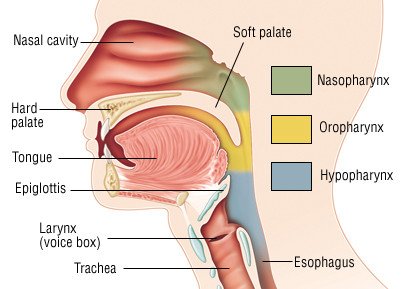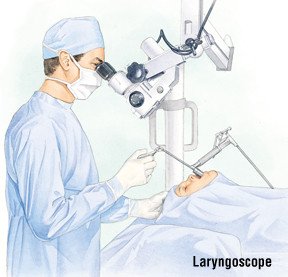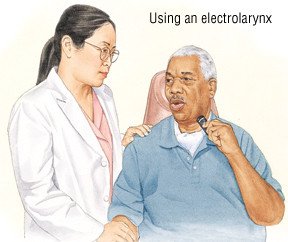Throat Cancer (Larynx and Pharynx)
Medically reviewed by Drugs.com. Last updated on Sep 20, 2023.
What is Throat Cancer (Larynx and Pharynx)?

Throat cancer occurs when cells in the organs used for breathing, speaking, and swallowing begin to divide rapidly and abnormally. Most throat cancer begins on the vocal cords. Later, it spreads to the voice box (larynx); to the back of the throat, including part of the tongue and the tonsils (this whole area is called the pharynx); or below the voice box to the subglottis and trachea (windpipe). An early symptom of throat cancer is unexplained hoarseness or a raspy voice.
|
|
Smokers are at high risk of throat cancer. Other people at risk include those who drink a lot of alcohol, especially if they also smoke. People with a vitamin A deficiency and certain types of human papillomavirus (HPV) infection also may be more likely to develop throat cancer.
Throat cancer is associated with other cancers. Fifteen percent of throat cancer patients also are diagnosed at the same time with cancer of the mouth, esophagus or lung. Another 10% to 20% of people with throat cancer develop these other cancers later on.
Throat cancer is more common among men, probably because smoking is more common among men. This type of cancer is less common among people under age 55. Many throat cancers can be treated successfully, but the treatment may affect the person's ability to speak.
Symptoms
When throat cancer affects your vocal cords, the first symptom is a change in the sound of your voice, especially a persistent rasp or hoarseness. Other symptoms of throat cancer include:
- Painful or difficult swallowing
- Persistent sore throat
- A sense of a "lump in the throat" or a need to swallow
- Swelling or pain in the neck
- Enlarged glands (lymph nodes) in the neck
- A persistent cough
- Wheezing or raspy breathing
- Unexplained weight loss
- Coughing up blood.
Diagnosis
If your doctor suspects you have throat cancer, he or she will examine your throat. This can be done with a long-handled mirror or with a lighted tube called a laryngoscope. A local anesthetic might be used to ease discomfort. If abnormalities are found, your doctor will do a biopsy, which involves removing tissue for examination in a laboratory under a microscope. Throat cancer can only be confirmed through a biopsy. Your doctor might send you for a test called a computed tomography (CT) scan. This special type of X-ray provides images of the body from different angles, producing a cross-sectional view. A CT scan can help to find the location of a tumor, help to judge whether a tumor can be removed surgically and help to determine the cancer's stage of development.
|
|
Doctors describe cancer using numerical stages. For example, a stage 0 or stage I tumor has not invaded very far into surrounding tissues, while a stage III or IV tumor may be penetrating throughout and beyond surrounding tissues.
PET scanning is the newest addition to the evaluation of the extent of a cancer spread. The test helps to evaluate whether lymph nodes in the neck have cancer and whether the cancer has spread to other parts of the body. It is proving to be very helpful in treatment planning and in long-term follow-up care.
Expected Duration
Without treatment, throat cancer will continue to grow.
Prevention
Because most risk factors are environmental rather than genetic, throat cancer can be prevented. Two keys to preventing throat cancer are:
- Stop smoking or using smokeless tobacco products.
- Use alcohol only in moderation. Most experts recommend that women avoid more than one drink a day and that men avoid more than two drinks a day.
Treatment
The type of treatment recommended depends largely on how far the cancer has spread at the time treatment begins. The preferred treatments for the early stages of throat cancer are radiation therapy and surgery. In more advanced cases, chemotherapy may be given in combination with surgery and/or radiation. When throat cancer already has spread widely throughout the body, chemotherapy may be given alone. Under these circumstances, surgery or radiation is unlikely to provide additional benefit, and it's unlikely the cancer can be cured.
Here is treatment information broken down by cancer stage:
- Stage 0 throat cancers usually can be treated by surgically stripping off the affected layer of tissue.
- Stage I or II throat cancers require surgery, radiation therapy or both. Radiation therapy can be highly successful with these cancers, but throat cancers rarely are found this early.
- Stage III or IV throat cancers likely will require some combination of surgery, radiation therapy and chemotherapy.
Most cancers at later stages require the surgical removal of part or all of the larynx or pharynx. Surgical removal of the larynx is called laryngectomy. Surgical removal of part or all of the pharynx is called pharyngectomy. A laryngectomy is the most common surgery for throat cancer. Even if only part of the larynx is removed, the patient will lose some speaking ability and will require special techniques or reconstructive procedures to regain the use of his or her voice.
|
|
Many centers now perform pharyngectomy robotic surgery. Complex operations that took hours and were quite debilitating can now be performed with greater efficiency using robotic assisted techniques.
A laryngectomy is the most common surgery for throat cancer. Even if only part of the larynx is removed, the patient will lose some of his or her ability to speak. He or she will need to learn special techniques or have reconstructive procedures to regain the use of his or her voice.
After treatment for throat cancer, some people will learn new ways to speak with voice aids, breathing techniques, and surgical restructuring. Because the pharynx is a passage to the digestive tract, patients undergoing pharyngectomy might need surgery to reconstruct the pharynx to allow food to pass through.If cancer cells have spread beyond the larynx or pharynx and into the lymph nodes, a surgery called neck dissection is required. In this surgery, lymph nodes thought to contain cancer cells are removed. This can help contain the cancer before it spreads throughout the body. After surgery, radiation therapy may be done to destroy remaining cancer cells.
When To Call a Professional
See a doctor if any symptoms of throat cancer, such as hoarseness, continue for more than two weeks. You may be referred to a specialist, called an ear, nose, and throat doctor (otolaryngologist), who deals mainly with disorders of the larynx and pharynx.
Prognosis
As with all cancers, the outlook is much better if throat cancer is found before it spreads. Although patients with earlier stages of throat cancer can be cured with surgery or radiation therapy, many have to learn new ways to speak. Also, throat cancer patients are at risk of developing other cancers in the mouth, throat, or esophagus. That's why follow-up examinations are crucial.
Additional Information
American Cancer Society (ACS)
https://www.cancer.org/
Cancer Research
https://www.cancerresearch.org/
National Cancer Institute (NCI)
https://www.cancer.gov/
American Academy of Otolaryngology-Head and Neck Surgery
https://www.entnet.org/
Further information
Always consult your healthcare provider to ensure the information displayed on this page applies to your personal circumstances.



